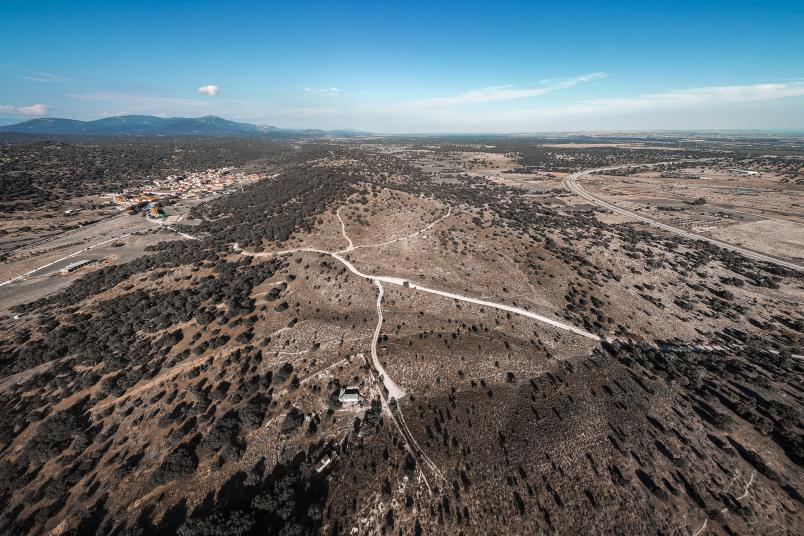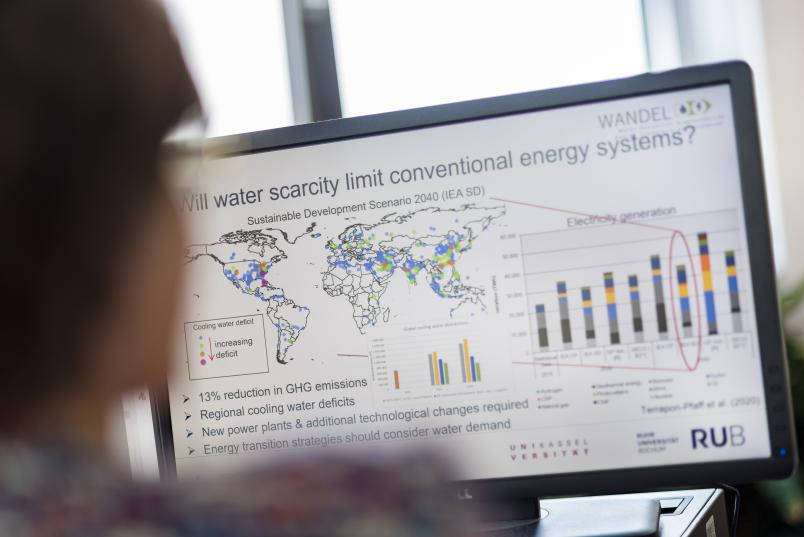
Hydrology
This is why freshwater must be considered in energy transition
Technologies with low CO2 emissions are the focus of energy transition. However, some of them consume enormous freshwater resources – water that won’t be available in sufficient quantities in many regions in the future.
Hydropower, biomass power generation, wind power, hydrogen, photovoltaics – these terms quickly come to mind when talking about the energy mix of the future. An energy mix that is supposed to combat climate change by limiting CO2 emissions. “But thinking in this way is too one-dimensional,” says Dr. Martina Flörke, Professor of Engineering Hydrology and Water Resources Management at RUB. She advocates not only looking at CO2 emissions, but also taking other environmental influences into account. For example, the impact on freshwater resources. The researcher provides an example: “Photovoltaic plants or solar power plants are obviously located where there is a lot of sun, which is usually in the dry regions of the world,” she says. “But solar power plants are also often cooled with water, and their mirrors have to be regularly cleaned of sand – with water.”
And yet, when planning for energy transition, water demand is often only considered for the location, while other water users and future developments are not factored in. However, the development of water supply and demand is crucial for the energy transition. Water can become a limiting factor for all sectors, and power plants that have not yet reached a critical level of use may be affected by water shortages in the future.

This was the focus of the research project “WANDEL – Water Resources as Important Factors of the Energy Transition at the Local and Global Level”, which was officially wrapped up at the end of 2020 and coordinated by Martina Flörke, first at the University of Kassel and then at RUB. The project partners calculated the impact of different forms of energy generation on water resources and revealed a dilemma: The quest for affordable and clean energy and for sufficient supply of good quality water – two of the UN’s 17 Sustainable Development Goals – are at odds with each other. “The Sustainable Development Goals were originally each drafted separately, but it presents a problem if we think of the goals in isolation,” says Martina Flörke.
Conflicting sustainability goals
The conflict between the water and energy goals can be seen, for example, in a concentrated solar power plant in Morocco that was assessed in the WANDEL project. It is situated in a sunny location and promises to produce around 370 million kilowatt hours of electricity per year. However, since it is partly cooled with water and its mirrors also have to be cleaned at regular intervals, it consumes five litres of water per kilowatt hour of electricity produced. “That doesn’t sound like much at first,” says Flörke. But the power plant would need two million cubic metres of water a year – and that in a dry region where a lot of agriculture is practised and where people depend on water for their daily lives. As a result of climate change, the future water supply could decrease even further. “This water should perhaps not be used to clean the mirrors in the power plant when people need it as drinking water,” points out Martina Flörke and adds: “In my opinion, competition for water as a resource is inevitable in the future.”
Model simulates global water supply
In the project, the researcher and her team used a model that calculates water supply and demand worldwide. The model, called “WaterGAP3”, divides the Earth’s land mass into 2.2 million grid cells and thus has a geographical resolution of five arc minutes. At the equator, this translates into a cell size of nine by nine square kilometres. For each land cell, the researchers fed physiographic and meteorological data into the model, such as land cover, soil types, daily precipitation, temperature and solar radiation. Based on this data, the algorithm simulates the terrestrial water cycle: how much precipitation in each cell infiltrates into the soil, evaporates and how much contributes to runoff generation and is then available as direct and groundwater runoff in rivers and aquifers. The simulation allows us to look back to pre-industrial times and make forecasts up to the year 2300.
The team calculated the water availability worldwide, taking into account only renewable freshwater resources, i.e. no fossil deep groundwater reserves. They then contrasted the water supply with the intended water extraction. To this end, they also included 48,000 locations of energy production plants and their water withdrawals and consumption.
Calculating water requirements for energy production
In order to make a forecast for the year 2040, the researchers relied on four future scenarios that Greenpeace and the International Energy Agency had drawn up. Presented in 2014/15, these scenarios outline how the energy mix could develop in the future. One scenario, for example, describes which forms of energy would help to limit global warming to two degrees Celsius and relies heavily on photovoltaics, solar power plants, biomass power generation, wind and hydropower.

The researchers reproduced this energy mix created by the four scenarios in their model. In the process, they assumed that in the future more electricity will be generated using this method at locations that, for example, already produce energy using photovoltaics today. “We can’t know, of course, at which sites more photovoltaic plants will be built in the future, so in our model we can only work with the sites that currently exist – even though this is certainly a weak point, because production will also take place at other sites going forward,” explains Martina Flörke.
However, this doesn’t affect the key points of the calculations: a deficit is to be expected at up to 42 per cent of the locations, because more water will be needed there in the future than is available. “And this doesn’t even take into account the fact that the water demand in these regions could also increase for other reasons, for example because fields have to be more frequently irrigated due to the effects of climate change,” adds the researcher.
Mediterranean region must prepare for extreme drought
Water deficits are to be expected primarily in the west of America, in the Middle East and north of Africa, in southern Europe as well as in certain locations in the south and east of China and India. “In the Mediterranean region in particular, it is very likely that extreme drought events will become more frequent,” says Flörke. Therefore, some of the locations that are currently being used for energy production must be fundamentally questioned.
“The model analysis clearly shows that it would definitely not be beneficial to expand energy production at the current locations,” concludes the Bochum-based researcher. In addition, more efficient technologies, storage options for water and energy as well as alternatives to the use of fresh water, for example treated wastewater, are needed. “However, I personally think that even that won’t be enough,” says Flörke. “We also have to reduce energy consumption.”
Is hydrogen the solution?
In the next step, Martina Flörke plans to explore so-called green hydrogen, i.e. hydrogen that is produced by electrolysis using renewable energies. The German government wants to rely more on this technology in the future. But it also needs a lot of water, because this is the raw material from which hydrogen is produced.

For me, wanting to achieve sustainability means having to think globally.
Martina Flörke
However, Martina Flörke doesn’t intend to focus on Germany alone. ”For me, wanting to achieve sustainability means having to think globally – because what we do in Germany also affects different regions in the world. We will only be able to achieve such global sustainability if we think across system boundaries and work together in an interdisciplinary way,” concludes the researcher.